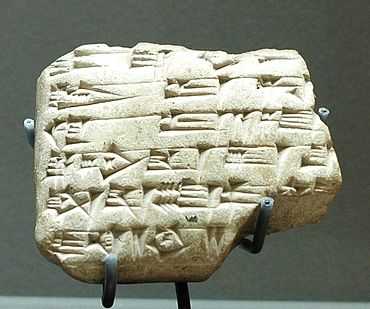Investiture of Zimri-Lim
|
Overview of the fresco | |
| Material | Mural painting on white plaster |
|---|---|
| Size | 4.25 square metres (45.7 sq ft) |
| Height | 1.7 metres (5 ft 7 in) |
| Width | 2.5 metres (8 ft 2 in) |
| Created | c. 18th century BC |
| Period/culture | Amorite |
| Discovered | 1935–1936 |
| Place | Royal palace of Mari, Syria |
| Present location | Musée du Louvre, Paris |
| Identification | AO 19826 |
The Investiture of Zimri-Lim is a large colorful mural discovered at the Royal Palace of the ancient city-state of Mari in eastern Syria. The fresco, which dates back to the 18th century BC, depicts Zimri-Lim, king of Mari, receiving the symbols of rule (a ring and a staff) from the goddess Ishtar.[1] The painting was discovered in situ on its original wall located opposite the grand doorway to the podium which leads to the throne room of the palace. It was discovered by French archaeologist André Parrot during excavations at Mari in 1935–1936. The painting is now displayed at the Musée du Louvre in Paris, France.[1]
Overview
| Mari |
 Euphrates • Terqa • Tuttul Royal Palace |
| Kings |
| Yaggid-Lim • Yahdun-Lim Yasmah-Adad Zimri-Lim (Queen Shibtu) |
| Archaeology |
| Investiture of Zimri-Lim Statue of Ebih-Il Statue of Iddi-Ilum |
The painting is composed of three vertical panels arranged symmetrically, with the two outer sections framing the central one.[2] The middle panel is divided horizontally into two rectangular registers framed by six parallel lines of different colors.[3] The painting's symmetry facilitates the reconstruction of the damaged part on the left panel.[2]
The painting is said to reflect the actual architecture of the palace in which the mural was located. The lower register of the middle panel reflects the podium room in which the body of a statue of a goddess similar to the goddess Lama depicted in the mural was discovered. The statue had a vase from which actual water flowed. The podium room opens up to the throne room, where the investiture takes place. The palm trees depicted in the side panels represent actual trees that were planted in the palace's courtyard.[1]
The upper register of the middle panel is the center of the mural and depicts the solemn scene of investiture. It is composed of five people standing against a blank background. Ishtar is depicted wearing her divine crown, with weapons sprouting from her shoulders and a sickle-sword in her left hand, and presenting the king with the symbols of authority (a ring and a staff). The king is extending his left hand to the goddess, while his right hand is depicted against his mouth in a symbol of prayer. On either side of the king and Ishtar stands a Lama deity, the minor goddess of intercession in Mesopotamia, wearing a horned headdress. To the right stands Ninshubur, the vassal of Ishtar.[3]
The lower register is symmetrical, and symbolizes the fertility and prosperity of the coming reign of Zimri-Lim. It shows the goddess Lama dispensing water from a round vase. Plants are shown sprouting from the vase, and fish swimming in the flowing stream.[4]
The outer panels depict a garden of palms and another mythical tree with a red trunk and blue leaves. A Lama deity is standing in the garden, on either side of the central scene, and raising her hands in prayer. Three mythic animals, a lion, a sphinx and a bull with a human head, are depicted each on a ground line. The animals are symmetrically placed on each side, and are turned towards the central scene in the painting. Flying doves, which symbolize the pacific aspects of Ishtar, counterbalance the lion which symbolizes her aggression.[3]
The symbols and iconography of the mural are often compared to the figures atop the Stele of Hammurabi.[5]
Restoration
The fresco was poorly preserved due to the region's conditions and the destruction of the palace in the fire when Hammurabi sacked the city in c. 1760 BC. The painting underwent several restorations and repainting, most of which was cleared recently by the Louvre. The cleaning revealed several details hitherto unseen, including the fish in the dispensed water. It also restored some brilliance to the colors of the painting.[1]
Gallery
-

The central register depicting the scene of investiture.
-

The winged lion symbolizes Ishtar's aggression.
-

The Lama deity dispensing water from a round vase.
-
Diagram of the mural.
See also
| Wikimedia Commons has media related to The Investiture of Zimri-Lim. |
References
Citations
Bibliography
- Schmandt-Besserat, Denise (2007). When Writing Met Art: From Symbol to Story. Austin, Texas: University of Texas Press. ISBN 9780292713345.
- Kuhrt, Amélie (1997). Ancient Near East C. 3000–330 BC. London: Routledge. ISBN 978-0-415-16763-5.
